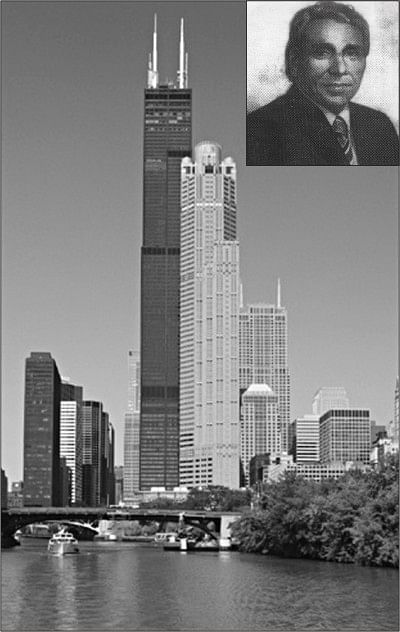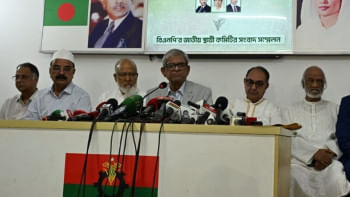FR Khan -- an architect who made us proud

Sears tower-- one of his many remarkable creations.
A prophet is not honoured in his own country" -- so goes the proverb. It is painfully true in case of Dr. Fazlur Rahman Khan, the legendary Bangladesh-born structural engineer. His achievements are hailed by men of science all over the world, obituary references to him were made even in leading magazines like Time and Newsweek (perhaps the only Bangladeshi non-political personality to be so honoured), he was acclaimed the 'Construction's Man of the Year' and accorded Alfred E. Lindau Award (considered to be the most precious in the world of architecture), he headed the prestigious Council on Tall Buildings and Urban Habitat for years (till the end of his days), and yet very few in our country are aware of his monumental contribution, world-wide fame and recognition.
F R Khan was an outstanding civil engineer who was hailed all over the globe for innovations in high-rise building construction, especially tubular design. He earned international fame for inventing the "bundled tube" system, a structural network consisting of narrow cylinders clustered together to form a thick tower, which minimized the amount of structural steel needed for high towers and eliminated the need for internal wind bracing. He was born in Dhaka on April 3, 1929 and obtained his Bachelor of Engineering degree from Shibpur Engineering College, University of Calcutta in 1950 at the top of his class. He worked as assistant engineer for the India Highway department, and then taught at the University of Dhaka.
Qualifying for a Fulbright scholarship in 1952, he enrolled at the University of Illinois (Urban), where he completed enough credits for two Master of Science degrees, one in applied mechanics and the other in structural engineering. He obtained a doctorate in the latter and accepted an engineering position in Skidmore, Owings and Merrill, a leading and world-renowned architectural firm in Chicago. He returned briefly to his native country (then East Pakistan) and won an important position as Executive Engineer of the Karachi Development Authority (KDA).
After serving KDA for more than three years (between 1957 and 1960), he came to the painful realisation that the environment in the then Pakistan was in no way congenial to the blossoming of a budding creative genius like him. Although he loved the motherland with all his heart, he was pained to find that the administrative demands in the KDA kept him from design works. He found no way out but to return to the United States where his talent and creativity would have ample opportunities to blossom in their full majesty and splendour. In1960, he joined Skidmore, Owings and Merrill once again and remained associated with it till his last breath. He shuffled off the mortal coil while on a job-site visit to Jeddah on March 27, 1982.
It was during the early 1960s that he laid the groundwork for his later successes in the field of high-rise buildings. His 1964 ASCE paper on shear-wall-frame interaction was a milestone in the development of economical high-rise buildings in both concrete and steel.
In the same period, Dr. Khan also initiated the tubular design concept, with its first application in the 43-storey reinforced concrete Chestnut-Dewitt apartment building in Chicago in 1963.
The next innovation, pushing still further the economically feasible height of multistory buildings, was the application of shear-wall-frame interaction principles to tubular structures, creating the tube-in-tube concept (a phrase coined by Khan), applied first to the Brunswick Building in Chicago. This concept was soon applied to many other structures, including the 52-storey One Shell Plaza, in Houston, which was the tallest reinforced concrete building in the world at the time of its completion.
Also, in the 60s came Khan's first steel version of the tubular structure: the diagonally braced, 100-storey John Hancock Building in Chicago. It became another milestone, particularly due to the strong expression of its dominant structural feature in the architectural facade of the building.
Then came the Sears Tower using a further innovation -- bundling nine tubes into a single structural system -- with 110 stories and 1450ft height, the world's tallest building in the 1970s. Like the John Hancock, it used about half the steel needed for a conventional tubular design.
A principal feature of Khan's work was to make highly efficient exterior tubular configurations carry the lateral loads imposed on multistory buildings, rather than assigning this role to less efficient interior frames which clutter the rentable space, as had been common. The innovations introduced by Khan not only improved the rigidity of tall buildings, resulting in their superior performance, but also resulted in substantial economies over the cost of buildings designed, using traditional schemes.
Dr. Khan's startling innovations did not, however, go unchallenged. Skeptics and high-brows in many a circle-criticised his innovative theories and questioned their feasibility. But the economy and effectiveness of his massive structures (among the world's tallest) silenced the critics once and for all. As a result, most of the ultra-high buildings today are built on principles introduced by him.
Dr. Khan indeed was an architect with a difference. He believed that there is beauty and simplicity in the structural form of a building that is natural to it from an engineering point of view. Instead of going for a preconceived architectural expression, he let the natural structural form be the architectural representation of a building. He was encouraged and supported in this bold effort by Bruce Graham, a dominant architectural figure at SOM. Khan and Graham jointly shaped the new skyline of many of the world's larger cities.
Khan's influence on the architecture of high-rise buildings was acknowledged by SOM with his admission, in the late 1960s, as a general partner in a firm that had heretofore only architect partners. Fazlur was later instrumental in the elevation of other structural and mechanical engineers to the status of partner.
In the non-high-rise category as well, a number of very remarkable projects were designed by Dr Khan. Of these mention may be made of the suspension roof of the Baxter Laboratories building near Deerfield, Illinois; the Hajj Terminal of the King Abdul Aziz Airport (fabric suspension roof) in Jeddah, which covers an area of 105 acres; the fabric suspension roof of the Humphrey Memorial Metrodome in Minneapolis; the University in Makkah; the US Air Force Academy in Colorado Springs; and the solar telescope at Kitt Peak, Arizona.
The honours received by Fazlur Rahman Khan during his chequred life are too numerous to be mentioned here. In 1972, he was proclaimed "Construction's Man of the Year" by the "Engineering News Record" for his many accomplishments in the field of ultra high-rise buildings. In 1973, he was the recipient of the Alfred E Lindau Award for his "outstanding contributions in advancing the art of reinforced concrete construction in high buildings". He also received the Wason Medal for Most Meritorious Paper in 1971 for his publication, co-authored with Mark Fintel, on "Shock-Absorbing Soft Story Concept for Multistory Earthquake Structures". He was honoured with the coveted and prestigious post of the chairman of the Council on Tall Buildings and Urban Habitat right from its inception until his death.
F R Khan had always been both human and humane. Unlike the average run of engineers, he never found himself confined to the dull and stereotyped environment of cut and dried formulae and techniques. Even beyond his intimate understanding of the non-structural disciplines and aesthetics and his exceptional intuitive understanding of structural behaviour, Khan had a remarkable perception of the social needs of the millions who live and work in the cities. Engineering and architecture were the media through which he sought to fulfil the needs. In the ultimate analysis, it was the urge to respond to human needs and aspirations that enabled Dr Khan to make the outstanding structures and innovations that brought him recognition and honour by society and profession.
F R Khan had the remarkable ability to articulate complex concepts in simple, understandable language. In spite of the intense demand of his busy professional life, he found time to regularly teach courses at the Illinois Institute of Technology, and to supervise graduate students. With his untiring activities, remarkable achievements and pleasant but commanding personality he inspired countless young engineers and set a standard for them to measure up against.
In 1971, when the merciless military junta launched the most heinous atrocity on the innocent unarmed civilian population in Bangladesh, Dr Khan, in spite of his heavy commitments and preoccupations, found enough time to organize the Bangalees and their friends in the United States into a Defense League which raised enormous funds for relief works. He also organized a strong lobby in Washington for months to urge the US authority to stop shipment of arms to the junta.
The enormous professional success did never affect the behaviour or the way of life of this great man. He remained humble, always accessible to his associates and friends, and continued his modest way of life.
Syed Ashraf Ali is former DG of Islamic Foundation Bangladesh.

 For all latest news, follow The Daily Star's Google News channel.
For all latest news, follow The Daily Star's Google News channel. 



Comments